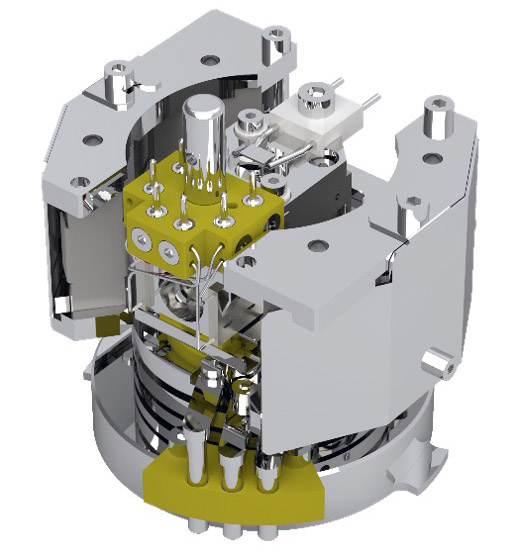Study on higher sensitivity for analysis of pesticide residues in foods by using GC-MS/MS (2)
MSTips No. 414
Introduction
The analysis of pesticide residues in foods requires the separation and detection of trace amounts of target pesticides present in complex matrices, and therefore, analytical instruments used for such measurements must have high performance. The GC-MS/MS method is effective for simultaneous analysis of multiple components in complex matrices, and is currently used by many analytical institutions as a general analytical method. Naturally, detection sensitivity can differ depending on the analytical instrument used, but various methods exist to increase the sensitivity of conventional analytical methods. The EPIS (Enhanced Performance Ion Source), a high-performance EI ion source developed exclusively for JEOL‘s quadrupole MS systems, uses a newly designed source magnet and chamber block to increase the amount of ions produced within the ion source chamber. The instrumental detection limit (IDL) of this ion source for SRM measurement is less than 0.4 fg (OFN 1 fg, n=8), which is very effective for the analysis of trace analytes. In this study, the results of using the EPIS as an ion source on the detection sensitivity in an analysis similar to MSTips No. 413 (application of cold splitless injection method) are presented.
Experimental

EPIS
1. Sample Conditions
| Standard reagents : | Pesticide Mixture Standard Solution PL-1, 2, 3, 4, 5, 6, 9, 10, 11, 12, 13 made by FUJIFILM Wako Pure Chemical Co. |
|---|---|
| Sample concentration : | Pesticide mixed standard solutions were prepared at 0.1, 0.5, 1, 2, 5, 10, and 20 ppb |
| Sample volume : | 2 μL (+ 0.2 μL co-injection of analyte protectants : SFA10mix made by Hayashi Pure Chemical Industry Co.) |
2. GC Conditions
| Gas chromatograph : | 8890GC (Agilent Technologies, Inc.) |
|---|---|
| Inlet mode : | Splitless mode |
| Inlet temperature : | 250°C |
| Column : | VF-5MS (length : 30 m, inner diameter : 0.25 mm, film thickness : 0.25 μm) |
| Oven temperature : | 50°C (1 min) → 125°C (25 deg C / min, 0 min) → 300°C (10°C / min, 10 min) |
| Flow rate : | 1.0 mL/min (constant flow) |
3. MS Conditions
| Mass spectrometer : | JMS-TQ4000GC (JEOL Ltd.) |
|---|---|
| Ion source : | Standard EI ion source and EPIS |
| Measurement mode : | SRM |
| SRM mode : | High-sensitivity mode |
| Ion source temperature : | 280°C |
| Interface temperature: | 300°C |
| Ionization voltage : | 70 eV |

JMS-TQ4000GC
Results
Of the 292 analytes selected for measurement, a total of 283 components were detectable at 0.1 ppb with the standard EI ion source (see MSTips No. 413 for a list of the compound names and retention times of all 283 detectable analytes). There were nine components that were difficult to detect at 0.1 ppb by conventional methods: procymidone, acetamiprid, halfenprox, imibenconazole, bifenox, flumiclorac pentyl, azoxystrobin, propaquizafop, and thiacloprid. Conversely, when EPIS was used as ion source, all the components were detectable at 0.1 ppb. Fig. 1 shows an EIC comparison at 0.1 ppb for three of the nine components that were difficult to detect with the standard EI ion source : imibenconazole, bifenox, and azoxystrobin. In order to confirm the effect of EPIS on sensitivity, peak area ratios (EPIS / standard EI) were calculated for the 283 components that were detected at 0.1 ppb in both ion sources and arranged in a scatter diagram (Fig.2) based on compound order (retention time order). The measurement results from MSTips No. 413 (application of cold splitless injection method) are also shown.

Fig.1 Comparison of EICs at 0.1 ppb (EI / EPIS)

Fig.2 Scatter diagram of area ratios (EPIS / EI) for 283 detected pesticides
By using EPIS, peak area ratios generally increased 5 to 10 times over the entire measurement region, although increases as much as 50X were observed. Even though the sample was at an extremely low concentration of 0.1 ppb, EPIS made it possible to stably detect components that were near the lower limit of detection with the standard EI ion source. Compared to the data obtained by applying the cold-splitless introduction method, EPIS use resulted in a greater overall improvement in sensitivity. In this study, none of the 283 pesticides detected by standard EI showed reduced sensitivity when measured by EPIS.
Conclusion
Data shows that there is a clear advantage to using EPIS in GC-MS/MS to measure pesticide residues compared to the standard EI ion source. Additionally, area ratios were generally higher than those obtained with the cold splitless injection method, confirming a greater sensitivity improvement. The use of EPIS for analysis of pesticides in food will be advantageous for jurisdictions with tight limits and large pesticide lists.
Solutions by field
Related products
Are you a medical professional or personnel engaged in medical care?
No
Please be reminded that these pages are not intended to provide the general public with information about the products.

